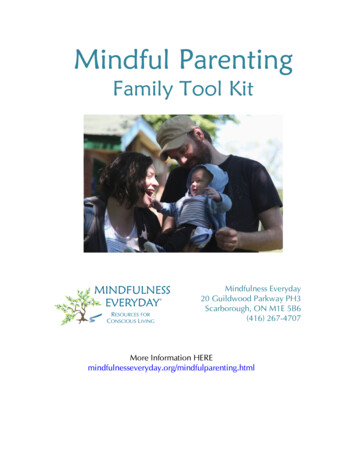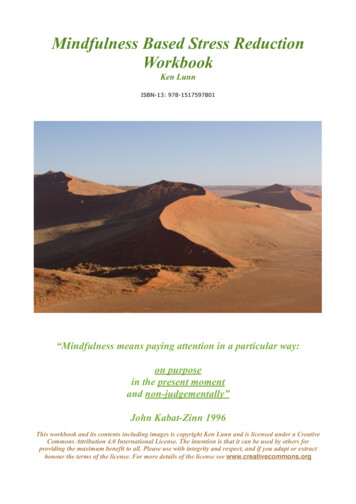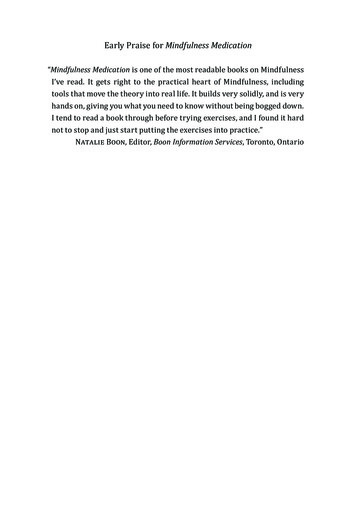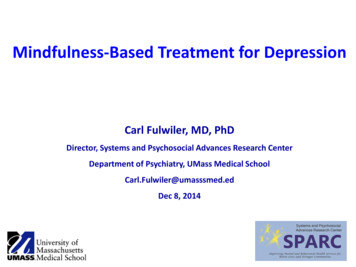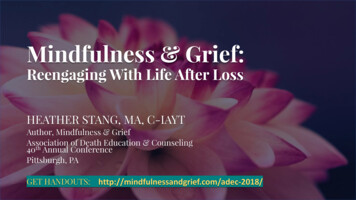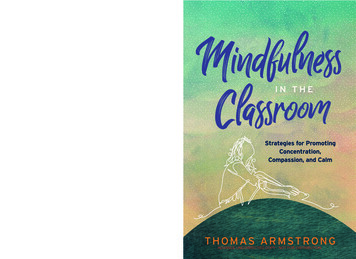
Transcription
E D U C AT I O N Explains how mindfulness affects the structure and function of the brain. Shares and explains the extensive research that shows the positive effectsof mindfulness practices in the classroom. Describes how to adapt mindfulness for different grade levels, integrateit into regular school subjects, and implement it schoolwide. Offers guidelines for teaching mindfulness responsibly, withoutreligious overtones.CLASSROOM Provides an overview of mindfulness as both a personal practice anda classroom methodology that aligns with such educational models asSocial and Emotional Learning (SEL), Positive Behavioral Interventionand Supports (PBIS), and Universal Design for Learning (UDL).IN THEIn Mindfulness in the Classroom, ArmstrongMINDFULNESSIn today’s schools, students and teachers feel unprecedented—even alarming—levels of stress. How can we create calmer classrooms inwhich students concentrate better and feel more positive about themselvesand others? Author Thomas Armstrong offers a compelling answer in theform of mindfulness, a secular practice he defines as the intentional focus ofone’s attention on the present moment in a nonjudgmental way.Dozens of observations from teachers, students, researchers, and practitionersprovide striking evidence of the power of mindfulness and offer hope to anyonewho wants to make classrooms more productive places of learning.ARMSTRONGSTUDYGUIDEONLINEADVANCE UNCORRECTED COPY - NOT FOR DISTRIBUTION
1703 N. Beauregard St. Alexandria, VA 22311-1714 USAPhone: 800-933-2723 or 703-578-9600 Fax: 703-575-5400Website: www.ascd.org E-mail: member@ascd.orgAuthor guidelines: www.ascd.org/writeRonn Nozoe, Interim CEO and Executive Director; Stefani Roth, Publisher; Genny Ostertag,Director, Content Acquisitions; Julie Houtz, Director, Book Editing & Production; Darcie Russell,Editor; Judi Connelly, Senior Art Director; Melissa Johnston, Freelance Graphic Designer; KeithDemmons, Senior Production Designer; Kelly Marshall, Interim Manager Production Services;Trinay Blake, E-Publishing SpecialistCopyright 2019 Thomas Armstrong. All rights reserved. It is illegal to reproduce copies of thiswork in print or electronic format (including reproductions displayed on a secure intranet orstored in a retrieval system or other electronic storage device from which copies can be made ordisplayed) without the prior written permission of the publisher. By purchasing only authorizedelectronic or print editions and not participating in or encouraging piracy of copyrighted materials, you support the rights of authors and publishers. Readers who wish to reproduce or republishexcerpts of this work in print or electronic format may do so for a small fee by contacting theCopyright Clearance Center (CCC), 222 Rosewood Dr., Danvers, MA 01923, USA (phone: 978-7508400; fax: 978-646-8600; web: www.copyright.com). To inquire about site licensing options or anyother reuse, contact ASCD Permissions at www.ascd.org/permissions, or permission@ascd.org, or703-575-5749. For a list of vendors authorized to license ASCD e-books to institutions, see www.ascd.org/epubs. Send translation inquiries to translations@ascd.org.ASCD and ASCD LEARN. TEACH. LEAD. are registered trademarks of ASCD. All other trademarks contained in this book are the property of, and reserved by, their respective owners, andare used for editorial and informational purposes only. No such use should be construed to implysponsorship or endorsement of the book by the respective owners.All web links in this book are correct as of the publication date below but may have become inactiveor otherwise modified since that time. If you notice a deactivated or changed link, please e-mailbooks@ascd.org with the words “Link Update” in the subject line. In your message, please specifythe web link, the book title, and the page number on which the link appears.PAPERBACK ISBN: 978-1-4166-2794-4 ASCD product #120018PDF E-BOOK ISBN: 978-1-4166-2796-8; see Books in Print for other formats.Quantity discounts are available: e-mail programteam@ascd.org or call 800-933-2723, ext. 5773,or 703-575-5773. For desk copies, go to www.ascd.org/deskcopy.ASCD Member Book No. FY19-8A (Jul 2019 PSI ). ASCD Member Books mail to Premium (P),Select (S), and Institutional Plus (I ) members on this schedule: Jan, PSI ; Feb, P; Apr, PSI ; May,P; Jul, PSI ; Aug, P; Sep, PSI ; Nov, PSI ; Dec, P. For current details on membership, see www.ascd.org/membership.Library of Congress Cataloging-in-Publication DataNames: Armstrong, Thomas, author.Title: Mindfulness in the classroom : strategies for promoting concentration,compassion, and calm / Thomas Armstrong.Description: Alexandria, Virginia, USA : ASCD, [2019] Includesbibliographical references and index.Identifiers: LCCN 2019014631 (print) LCCN 2019020080 (ebook) ISBN9781416627968 (Pdf) ISBN 9781416627944 (pbk. : alk. paper)Subjects: LCSH: Affective education. Reflective teaching. Mindfulness(Psychology)Classification: LCC LB1072 (ebook) LCC LB1072 .A75 2019 (print) DDC370.15/34--dc23LC record available at https://lccn.loc.gov/201901463129 28 27 26 25 24 23 22 21 20 191 2 3 4 5 6 7 8 9 10 11 12ADVANCE UNCORRECTED COPY - NOT FOR DISTRIBUTION
'flf,vt4fU t!SlC Slt'fJO Preface 11. Joining the Quiet Revolution 72. Reviewing Evidence from Neuroscience 203. Understanding the Basics 314. Practicing Self-Care as a Teacher 465. Teaching Kindness and Compassion 576. Adapting to Students’ Developmental Levels 677. Applying in the Content Areas 828. Expanding Schoolwide 969. Respecting the First Amendment 10810. Anticipating Future Challenges 118Appendix A: Glossary of Neuroscience Terms 123Appendix B: Resources for Mindfulness in Education 127References 134Index 151About the Author 159ADVANCE UNCORRECTED COPY - NOT FOR DISTRIBUTION
PrefaceThirty years ago I took an eight-week class in mindfulness meditation from clinical psychologist Jack Kornfield, author of several bestselling books on mindfulness. At the time, I was in the midst of a majordepressive episode and sought assistance from this practice in combatting my mood disorder. After a few weeks of meditating, my depressiongradually began to lift (research 15 years later would support the use ofmindfulness meditation in effectively treating depressive illnesses likemine). Years later, as my practice became more sporadic, I had a relapseof my depression, and this time I was more careful and made sure to doat least 30 minutes of mindfulness practice each day. That was almost10 years ago, and since then I’ve been depression free. I plan to practicemindfulness every day for the rest of my life.Since that time, mindfulness has taken off as a popular methodof personal and professional transformation. Thousands of studiesconducted throughout the past 20 years have demonstrated the effectiveness of mindfulness in treating a wide range of disorders, includingdepression, anxiety, post-traumatic stress disorder, eating disorders,chronic pain, and even psychosis.More recently the focus has turned to schools and well-designedrandomized controlled studies are highlighting the value of mindfulness practices in improving students’ executive functioning, bolstering1ADVANCE UNCORRECTED COPY - NOT FOR DISTRIBUTION
2Mindfulness in the Classroomworking memory, supporting social and emotional development, andreducing stress levels. Although the scientific study of mindfulness inthe schools is still in its infancy, with several long-term studies in progress and others planned for the future, there now is growing evidencesupporting the use of mindfulness to enhance concentration, compassion, and calm in the classroom.As I did the research for this book, I encountered the word mindfulness used in reference to a wide collection of interventions including mood lighting, relaxation strategies, jumping on a trampoline,stress-reducing coloring books, guided visualizations, chanting, andother body-mind activities. None of these are true examples of mindfulness—at least in the way that I’ll be using the term in this book. Ialso encountered confusion of the word mindfulness with the ideasof Harvard professor Ellen Langer (2014), who uses it in reference tothinking “outside of the box.”In this book, I’ll be using the word mindfulness in a very preciseway. Mindfulness, simply put, is the intentional focus of one’s attention on the present moment in a nonjudgmental way. The concept ofmindfulness has roots in Buddhism, especially Theravada Buddhism,which is predominant in Southeast Asia. However, my own referencepoint for the secular foundation of mindfulness comes from the workof biologist Jon Kabat-Zinn (2013). In the 1970s at the University ofMassachusetts Medical School, Kabat-Zinn developed a method fortreating chronic pain and stress through an eight-week course that hereferred to as Mindfulness-Based Stress Reduction (MBSR). The vastmajority of scientific studies on mindfulness over the past two decadeshave been based on this program and a related one called MindfulnessBased Cognitive Therapy (MBCT), which combines mindfulness experiences with standard cognitive-behavioral therapy. Although theapplication of mindfulness to the schools, and to students at differentages, requires many significant changes, adaptations, and modifications (these will be discussed in Chapter 6), many of the activities that Iwrite about (especially those described in Chapter 3) owe their originsto Kabat-Zinn’s MBSR program and to my own experiences practicingmindfulness over the past 30 years.ADVANCE UNCORRECTED COPY - NOT FOR DISTRIBUTION
PrefaceIt’s important for me to state from the outset that this book is nota formal program for implementing mindfulness in the schools or forformally training teachers to use mindfulness in their classrooms.There already are perhaps 30 to 40 programs that do this around theUnited States and in the United Kingdom and Australia (I list severalof these in Appendix B). Such programs vary in the methods they use,the services they provide, and the philosophies they espouse, althoughmost of them adhere to some version of Kabat-Zinn’s formulation ofmindfulness. This book, on the other hand, Provides an overview of mindfulness both as personal practiceand as a method to be used in the classroom. Details how mindfulness positively affects the brain’s structure and function, particularly in regard to its ability to deal withstress. Shows how mindfulness fits within existing education modelssuch as Social and Emotional Learning (SEL), Positive BehavioralInterventions and Supports (PBIS), and Universal Design forLearning (UDL). Reviews current evidence-based research on the effectivenessof mindfulness for use in the classroom. Communicates many of the essential features of mindfulnessprograms and practices. Offers suggestions for how mindfulness can be adapted at different grade levels. Provides ways of integrating mindfulness into the regular school curriculum (e.g., in language arts, math, science, socialstudies). Suggests several ways in which mindfulness can be implemented on a schoolwide basis. Enumerates guidelines to ensure that mindfulness is taughtin the schools in a responsible way (e.g., so that it doesn’t violate theseparation of church and state in the U.S. Constitution).The book is designed to meet a wide range of needs for educatorswith varying backgrounds and levels of experience. Mindfulness in theClassroom will appeal to several audiences, includingADVANCE UNCORRECTED COPY - NOT FOR DISTRIBUTION3
4Mindfulness in the Classroom Educators who are totally new to the subject of mindfulness,providing them with an overview and tools they need to start theirown practice and immediately begin using mindfulness in theirclassrooms. Teachers who have begun using a few mindfulness practices intheir classroom and want additional strategies and information forextending the practice. Teachers and administrators who have been using mindfulness in their classrooms for some time as part of a formal mindfulness program and are seeking ways to integrate mindfulness furtheron a schoolwide basis. Specialists who are working with at-risk kids or students inspecial education and want to offer emotional self-regulation strategies and provide activities that will improve executive functioningand reduce stress. School counselors and other support personnel who wish toadd mindfulness to their tool kit in helping students with emotionaland behavioral difficulties.I want to reiterate that mindfulness is a completely secular practiceif practiced in accordance with the guidelines discussed in this book(this issue will be explored in depth in Chapter 9). In researching thisbook, I was a bit alarmed to see the trappings of spirituality penetratingmindfulness practices in some public school classrooms, with kids sitting in the lotus position, using mudras (specific placement of the handswhile practicing), listening to Tibetan singing bells, and even chantingand receiving “spiritual” instruction (e.g., “the God in me sees the Godin you!”). Because the primary readers of this book will be public schooleducators, I cannot overemphasize the need to err on the side of secularity and make sure that religious or spiritual principles don’t seep intothe practices. Although the courts thus far have ruled in favor of yogaand mindfulness in the schools (see, for example, Perry, 2015), carelesspractice will only sow confusion and controversy that could ultimatelyundermine the entire use of mindfulness in the schools.My hope is that readers will develop a strong level of confidence inthe power of mindfulness practices to open up new potential in theirADVANCE UNCORRECTED COPY - NOT FOR DISTRIBUTION
Prefacestudents, leading to greater levels of social, emotional, and cognitivecompetence. As I point out in the first chapter, we’ve never experiencedtimes as stressful as they are now, and mindfulness has emerged justin the nick of time to offer students relief and greater levels of resilience in dealing with the pressures associated with this fast-paced,technology-ridden culture of ours. Happy reading, and may all of yourmoments be mindful ones!ADVANCE UNCORRECTED COPY - NOT FOR DISTRIBUTION5
ADVANCE UNCORRECTED COPY - NOT FOR DISTRIBUTION
1Joining theQuiet RevolutionAn epidemic is sweeping through our classrooms today. Not connectedto a virus, bacteria, or any other pathogen, the malady is stress. Our students are experiencing stress at levels never before seen in the historyof U.S. education. The statistics are alarming. Here are a few of them: One in 10 preschoolers has had suicidal thoughts (Whalen,Dixon-Gordon, Belden, Barch, & Luby, 2015). Doctors are increasingly reporting children in early elementary school suffering from migraine headaches and ulcers, and manyphysicians see a clear connection to pressure related to school performance (Abeles, 2016). A third of our adolescents report feeling depressed or overwhelmed because of stress, and their single biggest source of stress isschool (American Psychological Association, 2014). Roughly 1 in 4 girls and 1 in 10 boys in U.S. high schools try toharm themselves even when they are not attempting suicide (Monto,McRee, & Deryck, 2018). In a Yale University survey of more than 22,000 high schoolstudents, teens reported feeling stressed 80 percent of the time inschool (Brackett, 2016). By age 21, according to one longitudinal study, 82.5 percentof our students will have met the criteria for at least one psychiatric7ADVANCE UNCORRECTED COPY - NOT FOR DISTRIBUTION
8Mindfulness in the Classroomdisorder (Copeland, Shanahan, Costello, & Angold, 2011). (No, this isnot a misprint.)Student stress occurs at all levels of the socioeconomic pyramid.Dale Caldwell, former head of school at the Village Charter School inTrenton, New Jersey, uses the phrase “urban traumatic stress disorder” to describe the problem among those living in poverty. A consultant at the school, Trish Miele, talks about the anxiety that plaguesthese inner-city students: “So much of their life is living on the edgeof stress. . . . It could be food insufficiency, it could be general safety,not having a home, it could be abusive. . . . So many things are comingat them in the urban environment” (Buffum, 2017). On the other endof the economic spectrum, students are under tremendous pressureto perform academically. Reflecting on her experience teaching 3rdgrade in the wealthy West Windsor–Plainsboro public school districtfor 10 years, Miele comments, “The district is very high-achieving. . . . Iwould have kids coming to me when we started doing testing, [saying],‘If I don’t do well, I won’t get into Princeton!’ And I’m like, ‘You’re eight.What are you worrying about?’” (Buffum, 2017).The Mindful Solution to StressFortunately, schools are beginning to respond to this epidemic ofstress. One intervention that has received a great deal of attention overthe past few years is mindfulness: the nonjudgmental awareness ofeach present moment in time. Although rooted in a thousand-year-oldBuddhist tradition, mindfulness was given a solid secular foundationin science through the efforts of biologist Jon Kabat-Zinn, founderof the Stress Reduction Clinic at the University of MassachusettsMedical Center. He created a stress-reduction and chronic pain management program in the early 1970s based upon mindfulness (KabatZinn, 2013). Since that time, more than 3,000 scientific studies haveaddressed the topic of mindfulness (Regents of the University ofCalifornia, 2014). These studies have demonstrated the effectivenessof mindfulness practice in treating chronic pain (Garland et al., 2017);high blood pressure (Palta et al., 2012); immune function (Davidson etADVANCE UNCORRECTED COPY - NOT FOR DISTRIBUTION
Joining the Quiet Revolutional., 2003); anxiety (Vøllestad, Sivertsen, & Nielsen, 2011); depression(Kuyken et al., 2008); post-traumatic stress disorder (Possemato etal., 2016); eating disorders (Katterman, Kleinman, Hood, Nackers, &Corsica, 2014); psychosis (Aust & Bradshaw, 2017); substance abuse(Bowen et al., 2014); and a host of other mental and physical ills.Mindfulness in Popular CultureAs a result of such a strong evidence base, mindfulness has enteredpopular culture in the United States (as well as in the United Kingdomand Australia). The mindfulness and meditation industry has becomea one-billion-dollar-a-year business (Wieczner, 2016). Close to 80percent of all medical schools in the United States offer some aspectof mindfulness training in their programs (Barnes, Hattan, Black, &Schuman-Olivier, 2017). The National Health Service in the U.K. listsmindfulness as one of its five steps to mental well-being (NationalHealth Service, 2016). Chris Ruane, a member of the British Parliament,has set up a mindfulness training group for its MPs (Booth, 2017), andU.S. Representative Tim Ryan of Ohio has authored a book on mindfulness (Ryan, 2012) and promoted its widespread use among theAmerican electorate.These examples are just part of the mindfulness revolution. Inaddition, the U.S. Army has instituted a mindfulness program—Mindfulness-Based Mind Fitness Training (MMFT, pronounced“M-fit”)—to improve mental performance and bolster the emotionalhealth of soldiers under the stress and strain of war (Myers, 2015). TheNational Basketball Association (NBA) has teamed up with Headspace,a leading mindfulness app, to provide mindfulness training to allleague and team staff and family members (NBA Communications,2018). Mindfulness training is used in several Fortune 500 companies,such as Nike, General Mills, Goldman Sachs, Google, and Apple (Levin,2017). Even Sesame Street is using mindfulness principles. In one videocreated by the Children’s Television Workshop, the Count teachesCookie Monster how to concentrate on his breathing to reduce stress(to watch it, go to ount-breathe-relax/).ADVANCE UNCORRECTED COPY - NOT FOR DISTRIBUTION9
10Mindfulness in the ClassroomThe Growth of School-BasedMindfulness ProgramsThe first major effort to use mindfulness in the schools began in theUnited Kingdom in 2007 with a series of uniform lesson plans delivered in classrooms across the country (Davis, 2015). Over the pastdecade, several other programs have emerged to deliver mindfulness training in classrooms around the world. They include MindfulSchools, MindUP, Calm Classroom, Inner Explorer, Master Mind,Moment, A Still Quiet Place, Mindful Schools, the Attention Academy,Inward Bound Mindfulness Education, and Learning to Breathe (seeAppendix B for contact information on these and other mindfulnessprograms). MindUP reports reaching over 500,000 students aroundthe world in the past decade, and Mindful Schools says it has reachedover 300,000 students in the United States in the past five years(Strauss, 2016).Although alike in embracing mindfulness, these programs varyconsiderably. Some offer discrete training classes, whereas others usewhole-school or even districtwide immersion models. Program duration runs from four weeks to several years. Some use external facilitators to teach mindfulness, others train a school’s teachers to providethese lessons, and still others use no facilitators at all, relying uponaudio and video recordings to guide mindfulness sessions. Evaluationsof these programs reveal successful implementation, high recruitmentand retention rates, positive qualitative feedback from teachers andstudents, broad program dissemination, and long-term sustainability(Semple, Droutman, & Reid, 2017).What the Research Says About MindfulnessA number of school-related research projects are currently underway togauge the long-term effectiveness of mindfulness training in students.The Jefferson County Public Schools in Louisville, Kentucky, has partnered with the University of Virginia to implement the CompassionateSchools Project, a seven-year, 12 million research project based onADVANCE UNCORRECTED COPY - NOT FOR DISTRIBUTION
Joining the Quiet Revolutionmindfulness principles (Marshall, 2017). In the United Kingdom, theUniversity of Oxford has teamed up with University College Londonand the Medical Research Council in another seven-year project tostudy the application of mindfulness practice with adolescents in theschools, at a cost of 7.5 million (Mundasad, 2015). In Chicago, theErikson Institute, a developmentally based graduate school, has beengiven 3 million by the U.S. Department of Education to study theeffectiveness of mindfulness at 30 high-poverty schools encompassingmore than 2,000 students in kindergarten through 2nd grade (DeRuy,2016).Along with these longitudinal programs, there’s been a tsunamiof short-term studies on using mindfulness in the schools. These haveoffered preliminary evidence of the effectiveness of mindfulness withrespect to a wide range of important skills necessary for school success, including Executive functioning (Flook et al., 2010). Sustained attention (Gu, Xu, & Zhu, 2018). Working memory (Quach, Jastrowski Mano, & Alexander,2016). Social and emotional development (Schonert-Reichl & Lawlor,2010). Improved math performance (Schonert-Reichl et al., 2015). Self-regulation (Viglas & Perlman, 2018).Interestingly, two of these studies (Flook et al., 2010; Viglas & Perlman,2018) indicated that mindfulness practices were especially effective with students who had difficulties with executive functioning orself-regulation. Similarly, mindfulness appears to be very effectiveon a number of levels for low-income minority students in urban settings. One randomized controlled study, for example, published in theprestigious journal Pediatrics, showed improvements in urban, at-riskmiddle school students with respect to somatization (having medicalsymptoms without any known cause), depression, negative affect, negative coping, rumination, self-hostility, and post-traumatic symptomseverity (Sibinga, Webb, Ghazarian, & Ellen, 2016).ADVANCE UNCORRECTED COPY - NOT FOR DISTRIBUTION11
12Mindfulness in the ClassroomThere is also emerging research suggesting that mindfulnesspractices benefit students with special needs. One study of adolescentswith autism who went through nine weeks of mindfulness trainingsaw decreases in rumination, as well as improved social responsiveness, social communication, social cognition, and social motivation(de Bruin, Blom, Smit, van Steensel, & Bögels, 2015). A review of several recent studies concluded that mindfulness may prove to be anovel psychosocial intervention for students with ADHD (Cassone,2015). Mindfulness has shown effectiveness with a group of adolescentpsychiatric outpatients displaying a heterogeneous mix of emotionaland behavioral disorders. Those students engaged with MindfulnessBased Stress Reduction (MBSR) self-reported reduced symptoms ofanxiety, depression, and somatic distress, and increased self-esteemand sleep quality. Of clinical significance, the MBSR group showed ahigher percentage of diagnostic improvement over the course of thefive-month program (Biegel, Brown, Shapiro, & Schubert, 2009). Astudy of students with intellectual disabilities showed that mindfulness practice led to improved task performance and reduced taskavoidance (Kim & Kwon, 2018).As of 2019, there have been three separate meta-analyses of theexisting literature on mindfulness in the schools. Although metaanalyses can produce watered-down data due to differences amongthe studies analyzed, they can also be useful in determining the overalleffectiveness of an intervention across a wide range of studies (see Ahn,Ames, & Myers, 2012, for a discussion of strengths and weaknesses ofmeta-analyses in educational research). In the first meta-analysis,which included 19 studies using control groups (Zenner, HerrnlebenKurz, & Walach, 2014), overall effect sizes within and between groupswas .40 and .41 respectively (using Hedges’ g, a measure of effect size).An effect size of .40 is considered to be within the range of desiredintervention effects, according to Hattie (2008). The meta-analysisalso looked at specific components of desired effects and found a largeeffect size (.80) in cognitive performance among students in mindfulness studies.A second meta-analysis (Maynard, Solis, Miller, & Brendel, 2017)demonstrated a small, statistically significant positive effect onADVANCE UNCORRECTED COPY - NOT FOR DISTRIBUTION
Joining the Quiet Revolutioncognitive and socioemotional outcomes from mindfulness practicesin the schools but no significant effect on academic and behavioraloutcomes. A third meta-analysis (Klingbeil et al., 2017), examining 76studies involving 6,121 participants, found small positive effects (.32 incontrolled studies), which surprisingly became stronger at follow-up(.46), suggesting that mindfulness has a cascading effect long after thestudy has ended.Taken as a whole, these studies suggest small to moderate positiveeffects due to mindfulness-based practices in the schools. We mustkeep in mind, however, that the research on mindfulness in educationis still in its infancy, and future studies will help to illuminate whichfactors are most potent in initiating positive effects on students’ emotional well-being, cognitive performance, and academic achievement.Future studies also promise to indicate which interventions are mosteffective with specific groups of students.Teacher and StudentTestimonials for MindfulnessAnother way to gain insight into the benefits of mindfulness in schoolsis to listen to the teachers who are implementing these practices. LauraMarkus, 6th and 7th grade math teacher at Dunn Middle School in LosOlivos, California, reports that the school schedule “can be chaotic forsome students. They often come to my classroom after science class,where they may still be excited from setting something on fire justminutes before. . . . Taking a few minutes for quiet meditation at thebeginning of each class serves as a transition for students to get into adifferent mindset for learning the logic of math” (Dunn School, 2018).Jana Standish, school counselor at Colrain Central School in Colrain,Massachusetts, who leads mindfulness sessions for elementary schoolstudents, comments, “Children have so many activities—things they’reexpected to learn and memorize. They’re taking in so much information . . . just taking a little time to pause and feel your breathing is helpful” (Broncaccio, 2018). Intervention teacher Stacey Achterhoff, whohas worked with K–5 homeless students in the Duluth Public Schoolsin Minnesota, says,ADVANCE UNCORRECTED COPY - NOT FOR DISTRIBUTION13
14Mindfulness in the ClassroomThere were just so many layers of yuck to get through before we couldget to academics. . . . If we don’t address the trauma, then the kids aregoing to become stunted in academic growth. . . . When I go into theclassroom, I see that quiet magic of kids being able to settle into theirown bodies. . . . They see there’s power in being able to control whatthey can, when there are so many other things out of their control.(Zalaznick, 2017)We can also learn from the students themselves about the impactthat classroom-based mindfulness has had on their lives. One highschool student who had participated in a mindful se
mindfulness. This book, on the other hand, Provides an overview of mindfulness both as personal practice and as a method to be used in the classroom. Details how mindfulness positively affects the bra
